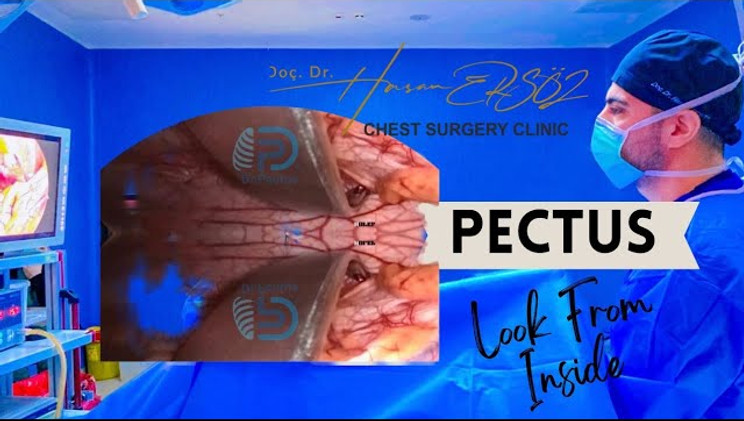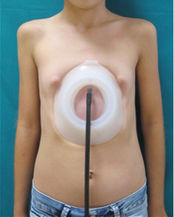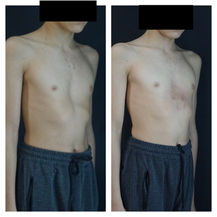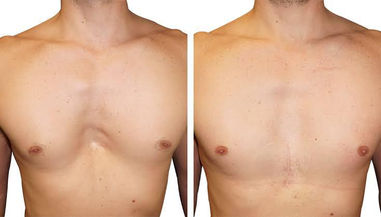
Pectus Excavatum (Sunken Chest)
What is Pectus Excavatum?
Pectus Excavatum (Sunken Chest) is also known also known as funnel chest or sunken chest. Pectus Excavatum is the inward collapse of the rib cage.
Pectus Excavatum is the most common type of chest wall deformity seen at a rate of one in 300 to 400 live births. It is not as rare as it is thought. Children with this deformity have very typical appearance: Narrow and thin chest, hooked shoulders, concave ribs and poor posture. Pectus excavatum that usually develops at birth or in the first years of life is noticed by the mother and relatives.
Although it regresses very rarely, the collapse is likely to get worse during puberty. For this reason, the most common age to consult a doctor is adolescence period. It is 4 times more common in men than in women. The cause of the collapse is known to excessive growth of the cartilage ribs, but the etiology is not known exactly. Unevenly growing cartilage pushes the rib sternum backward. An increased familial predisposition exists. Of patients, 37% have a family history of similar chest deformity(ies).
This deformity is often tolerated in childhood. The most common symptom is impaired effort tolerance. Exercise dystolerance should not be considered as patients returning home from school or work tired all day long. Exercise dystolerance is actually a sudden feeling of tiredness and breathlessness during exertion.
For example, while children of similar height and weight in the same age group can run up 5 flights of stairs without any problems, a child with pectus excavatum may be cut off from running on the third floor. Deformed cartilages can cause pain in the ribs and left breast area after exertion.
Palpitations and irregular heartbeats (arrhythmias) can also be observed after exertion. A heart murmur can be heard after a short exercise. Electrocardiographic changes may occur due to dislocation of the heart. When the deformity of the chest wall is corrected, improved lung and cardiac functions are observed.
Dislocation of the chest wall backward causes a sunk, especially on the anterior wall of the right ventricle of the heart. With the correction of its collapse, the sunk of the heart ventricle is corrected, as well. In the simplest terms, the collapse steals, as much as its volume, from the volume of the heart and lungs. In my own words, I always warn patients that “this deformity causes problems in old age, not in youth” This is because in old age, the stolen volumes of the heart and lungs due to deformity will be needed more in old age. In addition, postural disorders due to deformity will cause symptoms such as pain and limitation of movements in old age.
For respiratory and heart-related problems, the more pre-treatment collapse present, the more recovery should be expected. Many researchers have attributed the symptomatic deformity in pectus excavatum to a decrease in the volume of the chest cavity. It is difficult to prove the presence of this relationship because there is a wide range of cardiopulmonary function limits even in normal individuals. This totally depends on physical activity and body habits.An individual with pectus excavatum can also overcome many sports branches by forcing himself, build a beautiful body with bodybuilding, and become a swimmer. There are many examples of this in the world. However, it is certain that it will be beneficial to treat this deformity in order to do this sport more easily, to have a better body shape and to be more successful in the sport.
Would you like to see how the pectus deformity looks at the heart from the inside with surgical images?
Attention! The video may contain surgical footage. In this regard, we recommend that it not be watched next to sensitive individuals and children.
Pectus excavatum does not only affect the heart and lungs. Due to the pressure of the esophagus and stomach, it can cause the patients to feel full and hungry quickly, and this can cause the children not to be fed enough. You may find that most children with Funnel Chest remain underweight. The diaphragm is another organ whose function deteriorates under pressure. Diaphragm functions cannot be fully fulfilled in individuals with pectus excavatum. As a result, the breathing capacity of the patients, especially in the supine position, decreases. In daily life, this situation may occur with poor sleep quality. Sleep quality has been shown to be low in individuals with pectus excavatum. It is a well-known fact that individuals who sleep with low sleep quality for a long time will be more prone to heart attacks after a certain age.
In addition, if the patient is unhappy with this deformity, this alone creates a need for correction, even if it causes no dysfunction. The literature accepts this in this way. There are many patients expressing their unhappiness by saying that they have never swum in the sea without their T-shirt. Psychiatrists have conducted a high number of studies on this issue since 1960, and have used the term “mental deformity” for this condition. A study found problems such as anxiety, motivation disorder, labeling anxiety (82%), lack of self-confidence and timidity (78%), indecision (72%), and aggression (66%).
Treatments of Pectus Excavatum
There are surgical and non-surgical treatment options for chest collapse.
For more info view our Treatments






















